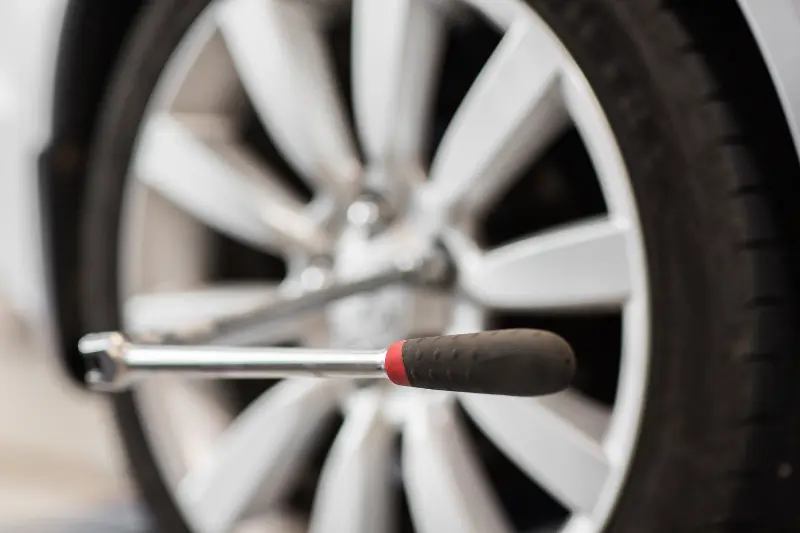When it comes to the tyres on your vehicle, ensuring they are the right size and type is crucial for both performance and safety. The question of whether you can fit tyres of different sizes on a car often arises among car owners looking to customise or replace their tyres. In this comprehensive guide, we delve into the considerations and implications of using different size tyres on your vehicle.
Can you fit tyres of different sizes on a car?
One common query is whether it is safe to have different size tyres on the front and rear of a vehicle. While it is technically possible to fit other-size tyres on the same car, it may only sometimes be recommended. Mixing tyre sizes on a vehicle can impact the overall performance, handling, and stability of the car.
It’s essential to consider the implications of using tyres with varying sizes on each axle. Different size tyres can lead to uneven wear, affect the alignment and suspension, and may alter the speedometer readings.
Moreover, there are legal restrictions regarding fitting different size tyres on a vehicle. Some jurisdictions have regulations that specify the acceptable tyre sizes and configurations to maintain road safety standards.

What are the considerations for using wider tyres?
Exploring the use of wider tyres raises questions about how they impact a car’s performance. Wider tyres offer improved traction and grip on the road, especially in wet or slippery conditions. However, fitting wider tyres may affect the handling and stability of a vehicle, particularly during cornering and braking.
Before opting for wider tyres, it’s essential to assess if any modifications are required to accommodate the new tyre sizes. Adjustments to the suspension, wheel wells, and alignment may be necessary to ensure proper fitment and performance.
How does tread pattern affect tyre compatibility?
The tread pattern on tyres plays a crucial role in determining their compatibility with each other. Mismatched tread patterns, when different types or patterns are combined on the exact vehicle, can lead to handling issues and reduced traction. Mixing different tread patterns may also result in uneven wear on the tyres, affecting their longevity and performance.
When considering tyre brands and tyre tread depth, it’s essential to ensure consistency across all tyres fitted on the vehicle to maintain optimal performance and safety standards.
Is it advisable to use tyres with smaller diameters?
Using tyres with smaller diameters can have implications for the braking system and traction of a car. Smaller tyres may lead to increased stopping distances, reduced grip on the road, and altered driving dynamics. While there may be specific circumstances where using smaller tyres is recommended, such as for off-road or specialised vehicles, it’s crucial to weigh the trade-offs in performance and safety.
Changing to smaller tyres may necessitate adjustments to the suspension, alignment, and braking components to maintain the vehicle’s handling and safety standards.

What happens when you have different size tyres on your car?
Having different size tyres on your car can significantly impact the overall performance and safety of the vehicle. Varied tyre sizes can result in uneven wear on the tyres, affect the alignment of the car, and potentially damage the suspension or drivetrain components.
In cases where different size tyres are the only option available, precautions should be taken to monitor the tyre conditions regularly, ensure proper inflation levels, and consider consulting with a professional for guidance on maintaining safe driving conditions.
Can I use different brand tyres on my car?
Can I use different brand tyres on my car? When it comes to car tyres, it’s always best to stick with the same brand and type of tyre on all four wheels. Mismatched tyres can affect the handling and performance of your vehicle. However, if you find yourself in a situation where you need to replace one tyre, it’s generally okay to use a different brand as long as the tyres on the rear are the same. Keep in mind that mixing tyres with extra width and diameter can lead to problems with your car’s handling and stability. It’s always a good idea to consult with a tyre expert or your vehicle manufacturer if you need help deciding which tyres to use.
It’s essential to ensure that the tyre size you choose is the correct size for your vehicle. Wheel sizes can vary depending on the type of car you have, so make sure to check your tyre size before purchasing. If you have two different sizes of tyres on your vehicle, it’s recommended to put the narrower tyres on the front wheels to improve handling. Additionally, fitting tyres with a higher speed rating than recommended by your vehicle manufacturer can also lead to problems with your car’s handling and performance.
Can you have different size tyres front and back?
When considering whether you can have different size tyres on the front and back of your vehicle, it’s essential to know that front tyres and rear tyres can indeed have variations in sizes, including different-width tyres or different diameters. This setup is often seen in sports cars where larger wheels on the rear axle help improve grip and stability, especially when the suspension geometry is tailored to accommodate different sizes. Nonetheless, while the front and rear wheels may differ in size, it is crucial that the tyres on one side of the car are matched for safety, ensuring that the tread is worn evenly across the vehicle.
For those unsure about their vehicle’s tyre setup or contemplating a change, a free tyre check at a Protyre garage can provide clarity. During the check, experts will advise on the recommended tyre size, examining aspects such as the rim, sidewall height, and whether your current setup may influence the speedo reading due to different diameter tyres. Individuals considering winter tyres or looking to replace a puncture can book a free tyre check to ensure that both the spare tyre and any new pair of tyres are the correct or equivalent tyre fit for their vehicle, whether it’s a drive vehicle with smaller wheels upfront or one with wide tyres for better performance. This attention to detail not only aids in passing an MOT but also ensures the safety of all road users.
Can you have different tyres on the same axle?
When wondering if you can have different tyre sizes on the same axle, it’s crucial to understand how the consistency of tyre dimensions plays a pivotal role in ensuring your vehicle will handle predictably across the same axle. Diverging from this by having one tyre that’s larger or smaller can significantly impact the handling characteristics, making the vehicle easier to turn on one side or causing a potential loss of control. For detailed insights, read on to find out why professionals at your local tyre shop commonly recommend fitting identical tyres not only in size but also in tread pattern and wear level.
Vehicles, especially those with rear-wheel drive, are designed with a precise balance in mind, where the suspension geometry is set to align with specific tyre specifications, including sidewall height as a percentage of width. Mixing tyres can create more rolling resistance, which in turn may use more fuel and also change the vehicle’s efficiency and environmental footprint. While budget constraints and stock availability sometimes may tempt you to mix tyres, remember that in the event you get a puncture, keeping a matching set ensures you can keep your speed and control, avoiding unnecessary complications across the UK.
Can you mix winter and summer tyres?
When you get a puncture and head to a tyre shop for a replacement, you might wonder if you can opt for different tyre sizes on the same axle. Mixing tyres across the same axle is not advisable because the handling characteristics of the vehicle would be negatively affected. The suspension geometry is set up for a specific tyre configuration, and deviating from this can lead to a loss of control or make the car easier to turn in one direction over the other. Read on to find out why experts recommend fitting the same size and type of tyre on both wheels of an axle.
Vehicles, especially those that are rear-wheel drive, are designed with precision in handling characteristics in mind. Using tyres of different sizes, or even tyres with different sidewall heights as a percentage, can create more rolling resistance and use more fuel. Moreover, mixing tyres can also change how the car handles, potentially making it unsafe. Hence, it’s crucial to keep tyres uniform across an axle. While budget constraints and stock availability may tempt you to mix tyres, the risks usually outweigh the costs. Shops across the UK often recommend fitting identical tyres not just for performance but for safety reasons, too. Always aim to keep your speed and handling predictable by ensuring your tyres match, especially across the same axle.
Is it illegal to have different tyres on your vehicle in the UK?
Mixing winter and summer tyres on the same vehicle is strongly discouraged by tyre manufacturers and automotive experts. While both types are designed to optimise vehicle performance and safety in their respective seasons, they have different tread patterns, rubber compounds, and performance characteristics. Winter tyres are made to provide better grip and handling in cold, icy, or snowy conditions due to a softer rubber compound and deeper tread patterns. Conversely, summer tyres are designed for warmer temperatures, offering enhanced traction and efficiency on dry and wet roads. Combining them can lead to uneven grip and handling, potentially compromising safety and vehicle performance.
Conclusion: Navigating the Complexities of Different Size tyres on Your Car
In conclusion, the ultimate guide to having different-sized tyres on a car serves as an essential resource for car owners seeking to understand the intricacies involved in tyre selection and the impact it may have on vehicle performance and legality. As explored, the compatibility of different tyre sizes is not a simple yes or no answer; it requires careful consideration of tyre dimensions, axle positioning, and the vehicle’s handling dynamics. Using mismatched tyres or varying tyre sizes on the front and rear axles can lead to significant safety risks, including uneven wear, compromised handling, and potential MOT failures.
The guide has underscored the legality concerns surrounding the use of different tyres on a vehicle, emphasising the importance of adhering to manufacturer recommendations and legal standards to avoid penalties. It has also highlighted how fitting wider or narrower tyres beyond recommended limits can affect the car’s functionality and safety features, such as the tread pattern’s compatibility and the suitability of the rim size for the tyre.
Ultimately, while there may be scenarios where different-sized tyres could be beneficial, such as in specialised performance settings, the average driver must prioritise consistency in tyre sizes across axles and ensure all tyres are suitable for the vehicle’s make and model. This guide serves as a cautionary reminder of the importance of maintaining uniform tyre sizes or closely adhering to manufacturer specifications to ensure optimal safety, performance, and legal compliance of your vehicle on the road.


